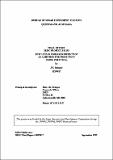| Author | Stringer, JK |
| Date Accessioned | 2012-11-13 |
| Date Available | 2012-11-13 |
| Issued | 1999 |
| Identifier | http://hdl.handle.net/11079/898 |
| Abstract | Until recently, BSES breeders used an empirical formula to assess the breeding potential of a parent (Hogarth and Skinner, 1986). Although this method uses data from many sources, it needs to draw on data accumulated for up to ten years to provide reliable estimates. An alternative is the statistical technique called Best Linear Unbiased Prediction (BLUP) which was developed to predict breeding values from dairy cattle data sets which are typically highly unbalanced and from diverse sources.The main objective of this study was to compare the relative efficiencies of BLUP and the existing empirical method for identifying superior sugarcane cross combinations. There was little difference in the agronomic performance of crosses selected using either BLUP or the empirical method but BLUP proved to be the quicker method and should allow more rapid progress from breeding and selection. |
| Language | en |
| Part of Series | BSES Internal Report; 1999 No 977 Report SD99017; BSS119 |
| Subject | Plant breeding |
| Subject | Cross pollination computers selection |
| Subject | Statistical analysis |
| Subject | Varieties |
| Subject | Plant breeding |
| Title | Best linear unbiased prediction as a method for predicting cross potential : SRDC final report BS119S |

